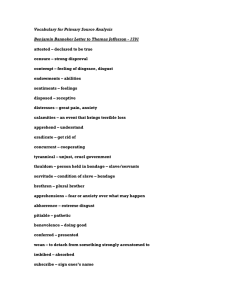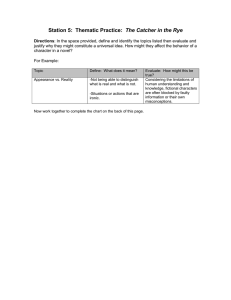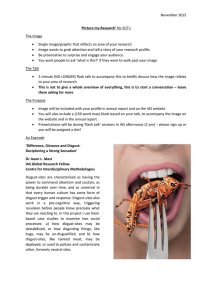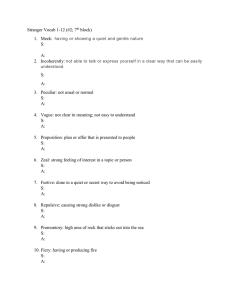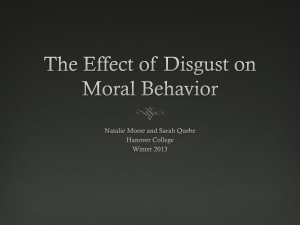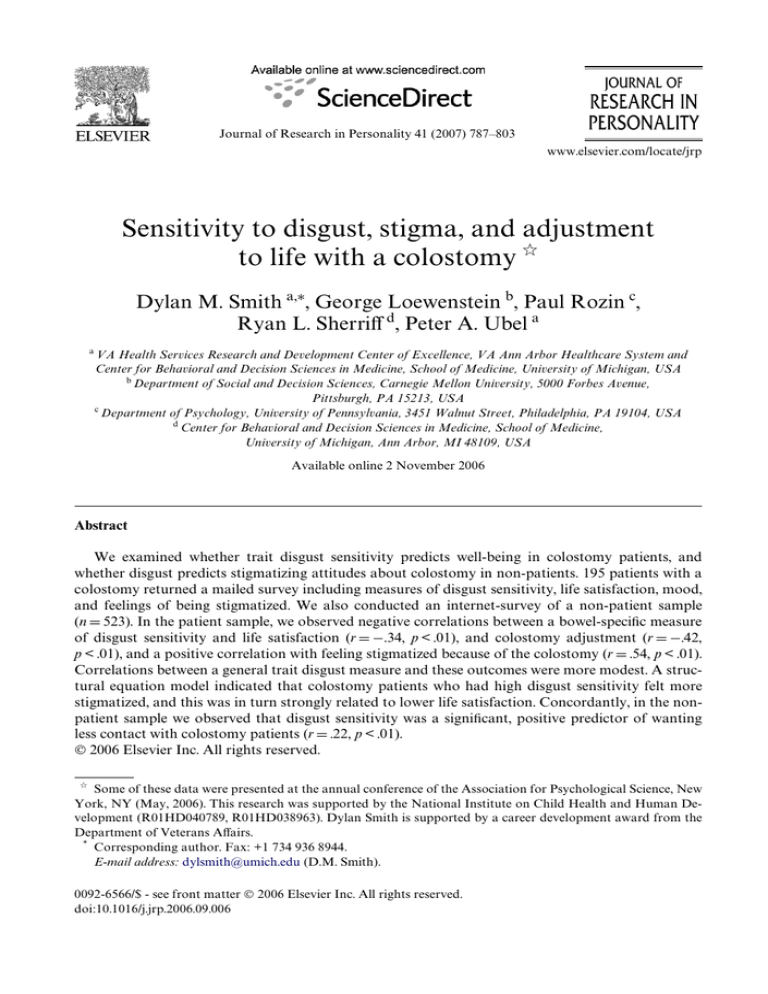
Journal of Research in Personality 41 (2007) 787–803
www.elsevier.com/locate/jrp
Sensitivity to disgust, stigma, and adjustment
to life with a colostomy 夽
Dylan M. Smith a,¤, George Loewenstein b, Paul Rozin c,
Ryan L. SherriV d, Peter A. Ubel a
a
VA Health Services Research and Development Center of Excellence, VA Ann Arbor Healthcare System and
Center for Behavioral and Decision Sciences in Medicine, School of Medicine, University of Michigan, USA
b
Department of Social and Decision Sciences, Carnegie Mellon University, 5000 Forbes Avenue,
Pittsburgh, PA 15213, USA
c
Department of Psychology, University of Pennsylvania, 3451 Walnut Street, Philadelphia, PA 19104, USA
d
Center for Behavioral and Decision Sciences in Medicine, School of Medicine,
University of Michigan, Ann Arbor, MI 48109, USA
Available online 2 November 2006
Abstract
We examined whether trait disgust sensitivity predicts well-being in colostomy patients, and
whether disgust predicts stigmatizing attitudes about colostomy in non-patients. 195 patients with a
colostomy returned a mailed survey including measures of disgust sensitivity, life satisfaction, mood,
and feelings of being stigmatized. We also conducted an internet-survey of a non-patient sample
(n D 523). In the patient sample, we observed negative correlations between a bowel-speciWc measure
of disgust sensitivity and life satisfaction (r D ¡.34, p < .01), and colostomy adjustment (r D ¡.42,
p < .01), and a positive correlation with feeling stigmatized because of the colostomy (r D .54, p < .01).
Correlations between a general trait disgust measure and these outcomes were more modest. A structural equation model indicated that colostomy patients who had high disgust sensitivity felt more
stigmatized, and this was in turn strongly related to lower life satisfaction. Concordantly, in the nonpatient sample we observed that disgust sensitivity was a signiWcant, positive predictor of wanting
less contact with colostomy patients (r D .22, p < .01).
© 2006 Elsevier Inc. All rights reserved.
夽
Some of these data were presented at the annual conference of the Association for Psychological Science, New
York, NY (May, 2006). This research was supported by the National Institute on Child Health and Human Development (R01HD040789, R01HD038963). Dylan Smith is supported by a career development award from the
Department of Veterans AVairs.
*
Corresponding author. Fax: +1 734 936 8944.
E-mail address: dylsmith@umich.edu (D.M. Smith).
0092-6566/$ - see front matter © 2006 Elsevier Inc. All rights reserved.
doi:10.1016/j.jrp.2006.09.006
788
D.M. Smith et al. / Journal of Research in Personality 41 (2007) 787–803
Keywords: Disgust; Stigma; Well-being; Disability
1. Introduction
People have an amazing ability to adapt to diYcult circumstances. Surveys of people
with seemingly severe disabilities, such as paraplegia and Parkinson’s disease, Wnd that
people report levels of emotional well-being that are often higher than one might expect
given their condition (Albrecht & Devlieger, 1999; Ubel, Loewenstein, & Jepson, 2003). In
one study, researchers provided palm pilots to a group of end-stage renal disease patients
receiving dialysis treatment, and to a group of matched, but healthy controls. The palm
pilots were programmed to administer short surveys of well-being several times a day over
a period of one week. Results of the study indicated that the average mood of the ESRD
patients was positive, almost as positive, in fact, as those of healthy controls, and patients’
moods were considerably higher than the predictions of healthy participants (Riis et al.,
2005).
Nonetheless, individual responses to negative events vary considerably. In a study of
grief and depression after bereavement, Bonanno and colleagues found evidence for several distinct “trajectories” of well-being after spousal loss. While some widows did well,
and recovered quickly, others showed low well-being that continued to decline one year
after the loss (Bonanno et al., 2002). As another example, while the study described in the
previous paragraph suggests that ESRD patients adapt well on average, other studies have
shown that some patients are susceptible to depression (Kimmel, Thamer, Richard, & Ray,
1998).
In investigating individual diVerence in reactions to adversity, researchers have examined whether factors such as an active coping style, the availability of social support, and
the resources associated with higher socioeconomic status can help people retain or more
quickly recover well-being after the onset of some adversity (e.g., Cohen & Wills, 1985;
Schulz & Decker, 1985). For example, results from a nationally representative survey indicated that after the onset of a signiWcant physical disability, people below the median in
income experienced a subsequent drop in well-being that was substantially greater than
that experienced by people above the median (Smith, Langa, Kabeto, & Ubel, 2005).
Factors like social support and coping style are generalized constructs, in that they
reXect individual diVerences in how people adjust to a broad range of adverse circumstances—and indeed, they have been studied in many contexts beyond any speciWc physical
disability, and beyond disability generally, in areas such as bereavement and unemployment (Bonanno et al., 2002; Vinokur & Price, 1989). But if we take a more idiosyncratic
approach, we may Wnd that many additional personality factors are relevant to understanding how people adjust to speciWc disabilities. Particular disabilities create unique challenges that could interact with relevant personality traits to aVect how well people respond
to those challenges. Consider the case of colostomy. People with this condition are confronted with distinctive issues that may have a negative eVect on their well-being—and
may pose special challenges for people high in some personality traits. SpeciWcally, in this
investigation, we will explore whether a personality trait that has not previously been
examined as a predictor of general coping—disgust sensitivity—plays a role in how people
respond to a medical condition—colostomy.
D.M. Smith et al. / Journal of Research in Personality 41 (2007) 787–803
789
1.1. Disgust sensitivity
Rozin, Haidt, and McCauley (1993) have proposed that disgust sensitivity (range and
intensity of negative response to “oVensive” events) likely originated as an aversion to
eating spoiled or otherwise dangerous foods. In modern times, disgust sensitivity has
been subsumed under a more generalized aversion to a wide range of stimuli or events
that are considered “oVensive” within any particular context. They noted that disgust
elicitors are usually so powerful that they elicit two types of rejection. First, even brief
contact with a disgust elicitor renders an otherwise acceptable object unacceptable (contamination, illustrating the law of contagion). Second, harmless replicas or images of
disgust elicitors may themselves elicit disgust (the law of similarity). Based on an analysis of disgust elicitors in the USA, Japan, and India, they identiWed seven domains in
which disgust is elicited, These were: foods, animals (especially those associated with
spoiled foods, such as cockroaches), body products (e.g., waste), hygiene (e.g., body
odor), sex, body envelope violations (including deformities of the body), and death
(Haidt, McCauley, & Rozin, 1994; Rozin, Haidt, & McCauley, 2000). Haidt et al. (1994)
developed a scale (the DScale) that assesses sensitivity to disgust reactions in each of
these seven domains. They validated their disgust sensitivity scale in behavioral tests of
reactions to actual or potential contact with a wide range of disgust elicitors (Rozin,
Haidt, McCauley, Dunlop, & Ashmore, 1999). They report positive correlations between
disgust sensitivity (the DScale) and fear of death and neuroticism, and negative correlations with experience seeking (Haidt et al., 1994).
To date, research on disgust sensitivity has focused on its relationships with other
psychological factors and pathologies, such as eating disorders, anxiety, obsessive compulsive disorder, and religious obsessions (Haidt et al., 1994; Olatunji, Tolin, Huppert, &
Lohr, 2005; Rozin et al., 1999, 2000; Thorpe, Patel, & Simonds, 2003). In this investigation, we wanted to see if disgust sensitivity would help to predict the extent to which
individuals adapt to a potentially disgust-inducing physical disability—in this case,
colostomy.
1.2. Challenges of living with a colostomy, including concerns with stigma
In colostomy and ileostomy surgeries, normal bowel function is interrupted, and waste
is passed through the abdominal wall through an opening called a stoma, to an appliance
which must be emptied periodically. Reasons for this surgery are varied, but the most common causes are colon cancer and inXammatory bowel syndrome. Overall physical functioning with a colostomy can be nearly unimpaired. Most patients learn to empty and clean
their appliance, and maintain care of their stoma, etc. The appliance itself is typically easily
hidden under clothing, and physical activity is generally not severely hampered, although
there may be restrictions on lifting heavy weights.
Nonetheless, adapting to life with a colostomy presents challenges. Occasionally,
patients may experience odors and noises caused by gas and waste passing through the
stoma. There is also the chance that the colostomy bag may leak if it is allowed to Wll
past capacity. Fundamental to our purpose, even a well-functioning colostomy appliance requires closer contact with fecal matter than is required with normal bowel functioning. As human feces prompt universal and strong disgust responses (Haidt et al.,
1994), colostomy patients may experience disgust reactions. There are four aspects of
790
D.M. Smith et al. / Journal of Research in Personality 41 (2007) 787–803
colostomy that could enhance disgust: (1) the exit of feces from the body in an unusual
location, (2) the lack of control of the time of exit; (3) the complexities of emptying and
replacing the appliance (more complex and more in the visual domain than the usual
anal cleansing process); and (4) the enhanced risk of noise and leakage.
Of course, given repeated experiences over time, this disgust response might be
expected to fade—indeed, this may be a key factor in successful adaptation to this particular disability. But, it seems likely that people with a greater disposition toward disgust sensitivity would take longer, and perhaps be less prone, to adapt to this
disability.1
In addition, people with colostomies may experience, or at least imagine, disgust reactions from other people. Previous research has shown that a disgust reaction plays a role in
stigmatization of outgroups (Cottrell & Neuberg, 2005), and at least one study has demonstrated that trait disgust sensitivity is positively associated with stigmatization of disabled
individuals (Park, Faulkner, & Schaller, 2003).
It could be that the potentially stigmatizing reactions of others could present another
diYculty in adapting to life with a colostomy. And patients who themselves are more easily
disgusted may be more likely to anticipate that others will react to their condition with disgust; thus, again, concern about stigma might be especially problematic for patients who
have higher trait disgust sensitivity.
To summarize, there are several reasons to expect that disgust sensitivity could be relevant to how patients adapt to colostomy, and to how colostomy patients are perceived by
non-patients. To begin to test these ideas, we gave a trait disgust inventory (Haidt et al.,
1994), and some additional items modiWed to speciWcally include items related to bowelrelated disgust responses, to three groups: a sample of current colostomy patients, a sample
of former colostomy patients, and a sample of the general public. We tested the following
hypotheses:
1. In colostomy patients, trait disgust—especially disgust that is speciWc to bowel function–will negatively predict life satisfaction and overall adjustment to life with a colostomy, and will positively predict negative experiences with their colostomies, and
feelings of stigmatization.
2. Because we argue that disgust sensitivity should be problematic for colostomy
patients as a result of the disgust arousing features of their condition, we predict
that the negative association with life satisfaction will be strongest among current
patients who are currently experiencing negative colostomy-related symptoms
(such as unwanted odors and leakage from their appliance), and weak or non-existent in a non-patient sample.
3. Using path and structural equation modeling, we will test whether the overall relationship between disgust and adjustment is mediated by concerns about stigmatization, negative experiences with colostomy symptoms, or both.
1
Feces normally exit the body through the anus, which has to be cleaned after each act of defecation. Few people seem to be upset by this process, presumably as a result of adaptation. Now imagine that the normal exit of feces from the body came from the lower front torso, where the colostomy stoma is usually located. Under these
conditions, disease necessitated surgery that caused the normal frontal exit to move to the location of the anus
might well produce a corresponding disgust response.
D.M. Smith et al. / Journal of Research in Personality 41 (2007) 787–803
791
2. Methods
2.1. Participants: Former and current colostomy patients
Using a database derived from hospital billing records, we identiWed 330 individuals
who had undergone colostomy or ileostomy surgery at the University of Michigan in the
last 5 years. To be eligible, participants must have been 18 or older at the survey time. Of
the eligible 330 individuals, 195 completed and returned the survey, giving us a 59.1%
response rate. We paid participants $25 per completed survey.2
2.2. Measures for both current and former patients
The survey consisted of questions about participants’ type of colostomy, reason for
undergoing the surgery, disgust (both general and colostomy-related), attitudes
toward colostomy-related events, experience adjusting to the colostomy, stigma
related to colostomy patients, and overall quality of life. The survey took approximately 45 min to complete. The survey also contained a skip pattern, such that general
measures of well-being and disgust sensitivity (both general and bowel-speciWc) were
asked of all patients, but only current patients responded to items that asked speciWcally about a current colostomy (e.g., questions about eYcacy in dealing with the
appliance).
2.2.1. Trait disgust
The standard disgust scale (Haidt et al., 1994) consists of 32 items, and takes too
long to complete in the context of this study. Instead, we used a shortened 8 item version (version 2, short form: (Haidt, McCauley, & Rozin, 2002)). The items on this form
were selected because of their range of coverage of types of disgust and high correlation with the total score. This D8Scale correlates about .90 with the full disgust scale.
It includes four statements about how respondents might react in certain potentially
disgusting or disturbing situations, such as “It would bother me tremendously to
touch a dead body.” Respondents indicated how much they agreed with the statements
on a scale from 1 (“Strongly disagree”) to 4 (“Strongly agree”). The second set of items
consists of four situations, including “You accidentally touch the ashes of a person
who has been cremated.” Respondents rated how disgusting each situation would be
to them, from “Not disgusting at all (1),” to “Very disgusting (4).” See Appendix B for
all eight items.
2.2.2. Colostomy-speciWc disgust
We developed two items on the survey to measure perceptions of disgust speciWcally
related to colostomies, based on similar items in the full Disgust Scale. Participants were
asked: “I am bothered by the odor caused by passing gas” and “The smell of other persons’
bowel movements disgusts me” on a 1–7 scale ranging from “Strongly disagree (1)” to
“Strongly agree (7).”
2
Other results from this data collection have been accepted for publication elsewhere (Smith, SherriV, Damschroder, Loewenstein, & Ubel, in press). The previous manuscript focuses on comparisons of utility valuations for
colostomy provided by patients, former patients, and non-patients.
792
D.M. Smith et al. / Journal of Research in Personality 41 (2007) 787–803
2.1.3. Life satisfaction
Overall life satisfaction was measured using the satisfaction with life scale (Diener,
Emmons, Larsen, & GriYn, 1985). This instrument comprises Wve statements about
respondents’ general feelings and attitudes concerning their life, such as “In most ways
my life is close to my ideal” and “So far I have gotten the important things I want in
life.” Respondents indicated how much they agreed or disagreed with these statements
on a 1– 7 scale ranging from “Strongly disagree (1)” to “Strongly agree (7).” We did
not include data from one item of the Life Satisfaction Scale in our composite (“If I
could live my life over, I would change nothing”), as we were concerned that it would
have a diVerent connotation for currently colostomy patients than for the other
groups.
2.1.4. Quality of life
An overall quality of life question asked participants to choose a number between 0 and
100 that best represents their current quality of life, where 0 represents the worst imaginable quality of life, and 100 represents the best imaginable quality of life.
2.3. Measures for current patients only
2.3.1. Colostomy adjustment
Several items were derived from the Cancer Self-EYcacy Scale (Lewis, 1996). These
items focused on how well current colostomy patients were dealing with circumstances and
challenges produced by having a colostomy. They include statements such as “I am able to
deal with the physical changes caused by the colostomy” and “I can lead a productive and
fulWlling life despite my colostomy.” Participants indicated how much they agreed or disagreed with the statements on a scale from 1 to 7. See Appendix B.
2.3.2. Colostomy-related symptoms
After consulting clinical staV who treat colostomy patients, we created a measure of
how frequently certain commonly experienced symptoms occurred. We also asked how
much these symptoms bothered participants, when they occurred. These included events
such as stoma bag leakage and the occurrence of irritation around the stoma. Respondents
indicated how many days in the past week that they experienced these symptoms. Separately, respondents indicated how much these problems bothered them on a scale ranging
from 1 (“Not at all”) to 7 (“Very Much”). See Appendix B.
2.3.3. Stigma
Six items assessed how much participants felt stigmatized by having a colostomy,
including assessments of whether they think others are disgusted by colostomy. See Appendix B.
2.4. Procedures for current and former patients
We sent each patient a survey, a payment form (mentioning that they would receive $25
for completing the study) and two self-addressed, stamped envelopes: one for the survey
and one for the payment form. Respondents returned the surveys and payment forms separately to further ensure the conWdentiality of their responses. No information identifying
D.M. Smith et al. / Journal of Research in Personality 41 (2007) 787–803
793
respondents was printed or written on the surveys; all contact and personal information
was maintained in a password-protected Wle.
If we did not receive a patient’s payment form within two weeks, we made a series of
reminder calls over the next several days and then called once in the evening. We left a message during the evening call if we were still unable to reach the patient. If patients did not
respond to the message or return the survey within two weeks, we sent a reminder letter
and another copy of the survey.
2.5. Participants—the non-patient sample
For the non-patient sample, participants were drawn from a panel of Internet users who
voluntarily agreed to participate in research surveys. This panel is administered by Survey
Sample International (SSI) and includes over 1 million unique member households
recruited through random digit dialing, banner ads, and other “permission-based” techniques. (For more information, see http://www.surveysampling.com). Individuals completing our web-based survey were entered into a drawing to win a cash prize of up to $1000.
Email invitations were sent to a sample of panel members stratiWed to mirror the US census population based on gender, education level, and income. Respondents over the age of
50 were oversampled.
A total of 7240 people received email messages inviting them to participate in an online
survey, and 606 clicked the embedded link to begin the survey (an 8.4% response rate). Of
these, 567 completed at least one measure, and 523 completed the full survey instrument, a
completion rate of 86%.
2.6. Measures—the non-patient sample
The non-patient sample provided demographic information, and read a brief description of colostomy (provided in Appendix A), and answered questions regarding their perception of quality of life with a colostomy. Relevant to the current investigation, they
completed the bowel-speciWc disgust measure and indicated the extent to which they felt
discomfort with the idea of close contact with a person with a colostomy (see Appendix B).
3. Results
3.1. Sample characteristics and reliability
Demographics for each of our three samples are reported in Table 1. Means, standard
deviations, and Cronbach’s coeYcients for our composite variables are presented in
Table 2. All of our composite variables demonstrated acceptable levels of internal reliability. As stated above, we did not include data from one item of the Life Satisfaction
Scale in our composite “If I could live my life over, I would change nothing.” Reliability
of this scale did not drop as a result of eliminating this item ( with 5 items D .918, with 4
items D .922). Therefore, the following analyses include only the four item version of the
scale.
In addition, across the two patient samples, the general disgust measure was signiWcantly and positively related to our modiWed speciWc disgust measure, as we expected
(r D .36, p < .01).
794
D.M. Smith et al. / Journal of Research in Personality 41 (2007) 787–803
Table 1
Sample demographics
Current
patients (n D 95)
Former
patients (n D 100)
Community
members (n D 567)
Mean age (standard deviation)
55.44 (15.01)
50.09 (17.34)
54.15 (16.03)
Gender
% Female
50%
47%
64%
Race
% Non White
12%
5%
28%
50.49 (67.68)
31.08 (17.32)
n/a
Mean number of months since colostomy
(standard deviation)
Median annual income (1–7)
1 D <$10K
2 D $10K–$25K
3 D $25K–$40K
4 D $40K–60K
5 D $60K–$80K
6 D $80K–$100K
7 D >$100k
Cause of colostomy/ileostomy
InXammatory bowel disease
Familial adenomatous polypsis
Cancer
Trauma/accident
Spinal cord injury
Other causea
More than one reason listed
3
3
29
3
41
1
1
13
5
42
4
11
5
0
26
11
4
n/a
Less than 6% of respondents had missing data on any item except for annual income (9%).
a
The most commonly cited reasons in this category involved various types of infections and surgical complications.
Table 2
Descriptive statistics and reliability among key composites
Mean (SD)
Observed range
Cronbach’s All patients (n D 195)
Life satisfaction (4; 1–7)a
Quality of life (1; 0–100)
General disgust (8; 1–4)
Bowel-speciWc disgust (2; 1–7)
4.46 (1.62)
69.47 (22.28)
2.52 (.65)
4.65 (1.38)
1.00–7
0–100
1.38–3.88
1.00–7
.92
n/a
.75
.71
Current patients (n D 95)
Colostomy adjustment (1–7)
Bothered by symptoms (1–7)
Stigma (1–7)
5.54 (1.30)
4.23 (1.99)
3.39 (1.54)
1.60–7
1.00–7
1.00–6.83
.90
.87
.90
a
The numbers in parentheses indicate the number of items, and scale range.
3.2. Correlations between speciWc disgust, general disgust, and well-being in current
colostomy patients
Correlations among our primary variables of interest are presented in Table 3. Both speciWc and general disgust were negatively related to colostomy adjustment, and were
D.M. Smith et al. / Journal of Research in Personality 41 (2007) 787–803
795
Table 3
Correlations in current patient sample (n D 95)
SpeciWc disgust General disgust
Spec. disgust
—
General Disgust
.26¤
Life sat.
¡.34¤¤
QOL
¡.33¤
Bother symps.
.49¤¤
Colost. adjust
¡.42¤¤
Stigma
.54¤¤
¤
¤¤
—
¡.12
¡.10
.01
¡.21¤
.20¤
Life sat.
QOL
Bother symps.
—
.76¤¤
¡.22¤
.62¤¤
¡.51¤¤
—
¡.21¤ —
.65¤¤ ¡.32¤¤
¡.52¤¤
.57¤¤
Colost. adjust Stigma
—
¡.55¤¤
—
p < .05.
p < .01.
positively related to feelings of stigmatization. SpeciWc disgust was also negatively related
to life satisfaction, and to quality of life.
We also observed strong, negative associations between perceptions of stigma and
colostomy adjustment, and life satisfaction. Reporting being bothered by symptoms was
also a signiWcant negative predictor of overall colostomy adjustment, life satisfaction, and
quality of life. The relation between bowel-speciWc disgust and the other variables was
always greater than the relation of general disgust to these same variables.
3.3. Comparisons with other samples
We predicted that the negative association with life satisfaction would be strongest
among current patients who are currently experiencing symptoms, and weak or non-existent
in a non-patient sample. As shown in Table 4, we observed no correlation between these two
variables in the non-patient sample. To test whether the diVerence in correlations was signiWcant, we performed a regression analyses in which we examined the eVect of patient status
(coded 1 for current patients, and 0 for non-patients), speciWc disgust, and the interaction of
these two variables in predicting life satisfaction. In this model, the interaction term was signiWcant (n D 655, t D ¡3.31, p < .01), indicating a signiWcantly stronger relationship between
disgust and life satisfaction for current patients than for non-patients. A similar interaction
was signiWcant for the quality of life variable (n D 652, t D ¡3.66, p < .001).
Next, we tested whether the eVects were stronger in current patients than in former
patients. As shown in Table 4, the correlations between disgust and life satisfaction, and
between disgust and quality of life, were lower in former patients. However, regression
analyses did not reveal a signiWcant interaction for either outcome variable (n D 192,
ps > .2).
Table 4
Correlations between bowel-speciWc disgust and well-being, by group
Life satisfaction
Quality of Life
¤
¤¤
¤¤¤
p < .10.
p < .05.
p < .01.
Current patients
with symptoms
Current patients
w/no symtoms
Non
patients
Former
patients
¡.38¤¤¤
¡.42¤¤¤
¡.16
¡.03
¡.01
.03
¡.18¤
¡.24¤¤
796
D.M. Smith et al. / Journal of Research in Personality 41 (2007) 787–803
We also tested whether, among current patients, the eVects of disgust on well-being
would be especially strong for patients who reported experiencing some colostomy-related
complicating symptoms over the past week. We conducted a regression analysis, with number of symptoms experienced and speciWc disgust, and the interaction of these two variables (both treated as continuous) predicting life satisfaction. This analysis conWrmed a
signiWcant interaction, indicating a stronger relationship between disgust and life satisfaction for patients who reported more symptoms (n D 93, t D ¡2.22, p < .05). A separate
regression model examining quality of life as the dependent variable also showed a signiWcant interaction (n D 93, t D ¡3.26, p < .01). As shown in Table 4, for the subset of current
patients who experienced at least 1 colostomy-related symptom in the last week, correlations between speciWc disgust and the well-being outcomes were the largest of any subgroup. Of note, general trait disgust, which was not a signiWcant predictor of life
satisfaction in the overall sample of current patients, was negatively related to life satisfaction in this subsample (r D ¡.29, p < .05).
3.4. Links between disgust, negative colostomy experiences, stigma, and well-being
Next, we considered two routes whereby disgust could inXuence adjustment to colostomy, and overall well-being for current patients. SpeciWcally, we hypothesized that disgust
sensitivity might: (a) increase the extent to which patients feel bothered by symptoms such
as leakage, or odors, and/or (b) increase the extent to which patients feel that others would
likely be disgusted by their colostomies, leading to feelings of stigmatization. Either or
both of these factors should, in turn, negatively inXuence adjustment to the colostomy.
Of course, given the cross sectional design, we cannot directly assess such causal
hypotheses. Therefore, we sought only to see if the patterns of associations between our
variables supported either or both of these hypothesized routes. To do so, we employed
path and structural equation modeling. The basic path model we tested is depicted in
Fig. 1. As can be seen in the Wgure, speciWc disgust sensitivity was positively associated
with both feelings of stigmatization, and (somewhat more weakly) with reports of being
Specific
Disgust
.49*
Bothered by
Symptoms
-.004, n.s.
.54*
Stigma
/others
disgusted
Colostomy
adjustment
-.55*
.61*
n = 95
RMSEA = .23
Bentler’s CFI = .85
* p < .01
Life
Satisfaction
Fig. 1. A path model showing relations between trait disgust, stigma, negative colostomy experiences, colostomy
adjustment, and overall QOL.
D.M. Smith et al. / Journal of Research in Personality 41 (2007) 787–803
797
bothered by negative colostomy symptoms. However, experiences with symptoms did
not signiWcantly predict colostomy adjustment in this model, and overall Wt was not adequate (RMSEA D .23, Bentler’s CFI D .85). Thus, we adjusted the model by dropping the
negative symptoms variable. Doing so reduced the number of estimated paths. Given
our sample size, we decided that this smaller model could be tested using a structural
equation model, without falling below 10 observations per estimated path. To compute
the model, we used SAS PROC CALIS (v.8) in lineqs mode, and maximum likelihood
estimation. In this model stigma, colostomy adjustment, and life satisfaction were
treated as latent variables (because the speciWc disgust composite had only two items, we
did not treat it as latent). Overall well-being was indicated by our three composites (Life
satisfaction, positive mood, and negative mood), each treated as a separate indicator (the
path between positive mood and the latent factor was constrained to equal 1.0). Colostomy adjustment was indicated by one variable that was actually a composite comprised
of the three eYcacy items; the other two variables in the Wve-item composite were each
treated as separate indicators (the path to the eYcacy composite was constrained to 1.0).
For stigma, we divided our six-item composite randomly into three 2 item composites,
each one treated as a separate indicator, and the path from one constrained to equal 1.0.
To summarize, this model estimated 6 indicator paths and 3 structural paths (from disgust to stigma, from stigma to colostomy adjustment, and from colostomy adjustment to
well-being), for a total of 9 (See Fig. 2).
Results indicate that all estimated indicator paths were highly signiWcant (all
ps < .001), and the six standardized path coeYcients ranged from .70 to .91. The structural paths were also highly signiWcant (all 3 ps < .001); the standardized path from speciWc disgust to stigma D .58, from stigma to colostomy adjustment D ¡.64, and from
colostomy adjustment to overall well-being D .81. This is a highly parsimonious model,
with direct links from disgust to colostomy adjustment, and to well-being constrained to
zero, as is the direct link from stigma to well-being. No errors among indicators were free
to covary. Nonetheless, this model Wt the data (RMSEA < .07, Bentler’s CFI D .98), suggesting that there is no need to add additional paths. A speciWc examination of
LaGrange multipliers revealed that none of the potential paths from speciWc disgust to
any other variable in the model would have improved Wt by a signiWcant amount (all
ps > .15).
.58*
Specific
Disgust
Stigma/
others
disgusted
-.64*
Colostomy
adjustment
.81*
n = 95
RMSEA < .07
Bentler’s CFI = .98
* p < .001
Fig. 2. Final structural equation model.
Life
Satisfaction
798
D.M. Smith et al. / Journal of Research in Personality 41 (2007) 787–803
3.5. Disgust and stigmatizing attitudes in the non-patient sample
Finally, we tested the hypothesis that non-patients higher in disgust sensitivity would
express a greater desire to distance themselves from someone with a colostomy. We
tested the association between the speciWc disgust measure and the two-item social distance composite and found a modest positive association between disgust sensitivity and
expressed discomfort with the idea of close contact with a colostomy patient (r D .22,
p < .001).
4. Discussion
We found preliminary evidence to suggest that disgust sensitivity is negatively associated with adjustment to having a colostomy. SpeciWcally, among colostomy patients,
we observed positive correlations between disgust sensitivity and feelings of stigmatization as a result of the colostomy and with feeling bothered by colostomy symptoms,
such as leakage. When a bowel-speciWc measure of disgust was considered, we also
observed negative correlations with overall life satisfaction, and with perceived quality
of life. These latter eVects were strongest among colostomy patients currently experiencing negative symptoms, and were essentially zero in a sample of non-patients.
This pattern is consistent with the idea that disgust represents a particular problem
for colostomy adjustment, as opposed to being a general predictor of lessened wellbeing.
Among current colostomy patients, those who had higher disgust sensitivity reported
higher levels of feeling stigmatized—they appeared to assume that others would be disgusted by their colostomy. This factor was, in turn, a strong negative predictor of colostomy adjustment and well-being. A path and structural equation model suggested that
the inXuence of disgust sensitivity on colostomy adjustment and life satisfaction
occurred primarily via feelings of stigmatization, rather than feeling bothered by colostomy symptoms.
Finally, data from the non-patient sample appeared to verify the patients’ concerns
about stigmatization. Non-patients who themselves reported higher disgust sensitivity
reported less comfort with the idea of close contact with a colostomy patient.
We can readily postulate at least two diVerent frameworks for thinking about the negative impact of disgust sensitivity on perceived stigma and colostomy adjustment. First, it
could be that having a pre-existing high sensitivity to disgusting stimuli puts you at greater
risk, if you experience the onset of a potentially disgust-inducing disability, like colostomy.
Alternatively, it could be that the people who adjust successfully to a colostomy do so in
part by reducing their sensitivity to certain kinds of disgusting stimuli, resulting in lower
levels of reported disgust along with higher levels of well-being. Consistent with this
notion, we found that bowel-speciWc disgust sensitivity is slightly, but signiWcantly, lower in
the current patient sample than in the general public sample (M D 4.57 vs. M D 5.09,
p < .01).
Given the cross-sectional design, we cannot tease apart these two alternatives. That is,
although disgust sensitivity has been conceptualized as a stable personality trait, we cannot
say for sure whether disgust sensitivity is a cause of, or eVect of, poor adjustment to having
a colostomy. Ultimately, longitudinal and perhaps prospective designs will be needed to
further understand these relationships.
D.M. Smith et al. / Journal of Research in Personality 41 (2007) 787–803
799
In addition, we cannot rule out the possibility that our disgust measures are proxies for
other, related constructs. As discussed in the introduction, previous work has shown that
disgust is related to factors like neuroticism, and obsessive tendencies, and it is possible
that these variables are also related to lower colostomy adjustment. We would argue that
the stronger associations between disgust and well-being among current patients with
symptoms, and the lack of association in the non-patient sample, suggest that disgust is
speciWcally a problem for colostomy, and thus not standing in for a broad personality variable such as neuroticism. But we cannot completely dismiss the possibility of a confounding third variable. Similarly, although we have argued that disgust is important to
colostomy adjustment via its association with stigma, and less through its association with
negative symptoms, it is possible that this pattern is speciWc to the measures we used. Perhaps other, unmeasured, aspects of the colostomy experience would also have proved
important.
Other limitations include the use of convenience samples for both patients and nonpatient samples. In addition, as is often the case with web-based studies, the response rate
for our internet sample was low. Both of these factors potentially limit the generalizability
of our results, although we do not have a speciWc reason to think that the associations
observed would be diVerent in a more representative sample. (Note: In a separate study
using the same internet methods, and similar response rates, sample, etc, we found agerelated trends in happiness that mirror those found in more representative samples (Lacey,
Smith, & Ubel, 2006).)
Finally, the strongest eVects of disgust sensitivity were observed using a previously
untested measure that was speciWc to bowel-related disgust. This measure was reliable, and
was positively correlated with the general disgust measure; however, it has only two items,
was created as an ad hoc measure for this survey, and thus could probably be improved
upon. A better measure might reveal even stronger associations between colostomy adjustment and life satisfaction.
4.1. Implications
The current data—while they must be considered preliminary–add to the literature on
how the tendency to respond more or less strongly to noxious stimuli aVects other psychological variables. As reviewed in the introduction, high disgust sensitivity has previously been
linked with obsessive tendencies, and with neuroticism among other variables. But we think
this is the Wrst study to demonstrate that high disgust sensitivity might negatively inXuence
well-being as a whole, under some circumstances. SpeciWcally, our data provide initial evidence that repeated exposure to noxious stimuli – in the form of a potentially disgust inducing disability – is a problem for the well-being of people with higher disgust sensitivity.
There are potential clinical implications of these Wndings. If trait disgust sensitivity
before a colostomy can predict adaptation afterward (something that needs to be veriWed
in prospective studies), then disgust measures could become useful tools to help identify
patients who might need more help in adjusting to their condition. Indeed, while global disgust sensitivity may be a fairly Wxed trait, bowel speciWc sensitivity might be modiWable.
Interventions could be devised that de-sensitize responses to bowel functioning, reducing
bowel disgust sensitivity and aiding in the adaptation process.
In addition, many individuals with inXammatory bowel syndrome have an option of
whether to have a colostomy, balancing the negative features of the colostomy against the
800
D.M. Smith et al. / Journal of Research in Personality 41 (2007) 787–803
symptom relief it would produce. Insofar as bowel-speciWc disgust sensitivity will predict
the degree of adaptation, it could be employed as a factor in determining the advisability of
an elective colostomy. Given the extremely high correlation observed between colostomy
adjustment and overall life satisfaction, it is important to make the choice of elective colostomy as informed as possible.
Our data also suggest that disgust plays a role in perceived and actual stigmatization of
disabled patients. More easily disgusted patients reported higher levels of concern about
being stigmatized by others—perhaps anticipating a disgust reaction from others—and these
concerns in turn were associated with much lower well-being. These data were mirrored by
data from a non-patient sample, which conWrmed that disgust plays a role in how people
respond to this disability. These Wndings are consistent with the idea that disgust plays a role
in stigma processes, and adds to the small, but growing literature emphasizing the important
of speciWc emotional reactions to speciWc stigmatizing conditions, as opposed to broader
reactions like dislike (Cottrell & Neuberg, 2005; Neuberg, Smith, & Asher, 2000).
Previous investigations on adjustment to disability have focused on general responses
to adversity (e.g., social support, coping style, optimism, etc.). What is relatively unique
about our approach is the consideration of how the speciWc challenges posed by a disability would interact with a personality trait speciWcally relevant to that disability.
Although we have focused on colostomy, disgust sensitivity could plausibly be related to
other physical health conditions, such as amputation and incontinence. In addition, personality traits other than disgust might make it easier or more diYcult to adapt to speciWc disabilities, as well as life challenges beyond disability and physical health. Thus,
while the current Wndings must be interpreted cautiously, given the modest study design,
we think they are both novel and important, and hope they will motivate future studies
using more powerful designs.
Acknowledgments
The authors thank Ingrid Dickinson and Mona Clarkson, from the OYce of Enterostomal Therapy at the University of Michigan Medical Center, whose assistance has made
conducting this research possible. We also wish to thank our collaborating surgeons,
Saman Arbabi, Richard Burney, Vincent Cimmino, Lisa Colletti, Frederic Eckhauser,
Mark Hemmila, James Knol, Michael Mullholland, Diane Simeone and Vernon Sondak,
for their help in conducting this study.
Appendix A. Colostomy description provided to community sample
Imagine that you have a colostomy. A colostomy is an operation involving the surgical
redirection of your bowels through a hole created in your gut, called a stoma.
Waste passes through your intestines and out the stoma into a bag, which you must
empty several times a day. If you wear relatively loose clothing, this bag will not be visible
underneath your garments.
Occasionally, you will experience odors and noises caused by gas and waste passing
through the stoma. There is also the chance that the colostomy bag may leak if it is allowed
to Wll past capacity.
Although you will be restricted from lifting very heavy weight, your daily activities will
not otherwise be greatly aVected.
D.M. Smith et al. / Journal of Research in Personality 41 (2007) 787–803
801
Appendix B. Measures
General disgust:
The following questions are about how you might react in certain situations. Please indicate how
much you agree with each of the following statements, or how true it is about you. Please write
a number (1, 2, 3 or 4) to indicate your answer:
1 = Strongly disagree (very untrue about me)
2 = Mildly disagree (somewhat untrue about me)
3 = Mildly agree (somewhat true about me)
4 = Strongly agree (very true about me)
____1. I try to avoid letting any part of my body touch the toilet seat in a public restroom,
even when it appears clean
____2. It would make me uncomfortable to hear a couple making love in the next room of
a hotel
____3. It would bother me tremendously to touch a dead body
____4. Even if I was hungry, I would not drink a bowl of my favorite soup if it had been
stirred by a used but thoroughly washed Xy-swatter
How disgusting would you find each of the following experiences? Please write a number
(1, 2, 3, or 4) to indicate your answer:
1 = Not disgusting at all, 2 = Slightly disgusting, 3 = Moderately disgusting, 4 = Very
disgusting
(If you think something is bad or unpleasant, but not disgusting, you should write "1".)
____5. You take a sip of soda and then realize that you picked up the wrong can, which a
stranger had been drinking out of
____6. You hear about a 30 year old man who seeks sexual relationships with 80 year old
women
____7. While you are walking through a tunnel under a railroad track, you smell urine
____8. You accidentally touch the ashes of a person who has been cremated
Stigma (1 D strongly disagree, 7 D strongly agree):
I think other people Wnd ostomies to be extremely disgusting
I feel embarrassed by my ostomy
I think other people would be uncomfortable around me if they knew about my
stoma
I feel rejected by other people because of my ostomy
To what extent does your ostomy make you feel embarrassed or socially uncomfortable?
(1Dnot at all, 7Dvery much)
To what extent does your ostomy make you feel stigmatized? ? (1Dnot at all, 7Dvery much)
Negative experiences with symptoms:
How much does it bother you when you have (1Dnot at all, 7Dvery much, 99Dnever
happens (recoded as 1)):
802
D.M. Smith et al. / Journal of Research in Personality 41 (2007) 787–803
Leakage from your stoma bag?
The smell of stool coming from your stoma bag?
Noise coming from your stoma bag?
Colostomy adjustment (1Dstrongly disagree, 7Dstrongly agree):
I have the ability to handle the challenges from the ostomy and its treatments.
I am able to deal with the physical changes caused by the ostomy.
I have the ability to take the necessary steps to work through the demands from the
ostomy and its treatments
I think I am leading quite a normal life despite my ostomy
I can lead a productive and fulWlling life despite my ostomy
References
Albrecht, G. L., & Devlieger, P. J. (1999). The disability paradox: high quality of life against all odds. Social Science and Medicine, 48(8), 977–988.
Bonanno, G. A., Wortman, C. B., Lehman, D. R., Tweed, R. G., Haring, M., Sonnega, J., et al. (2002). Resilience to
loss and chronic grief: a prospective study from preloss to 18-months postloss. Journal of Personality and
Social Psychology, 83(5), 1150–1164.
Cohen, S., & Wills, T. A. (1985). Stress, social support, and the buVering hypothesis. Psychological Bulletin, 98(2),
310–357.
Cottrell, C. A., & Neuberg, S. L. (2005). DiVerent emotional reactions to diVerent groups: a sociofunctional
threat-based approach to “prejudice”. Journal of Personality and Social Psychology, 88(5), 770–789.
Diener, E., Emmons, R. A., Larsen, R. J., & GriYn, S. (1985). The Satisfaction With Life Scale. Journal of Personality Assessment, 49, 71–75.
Haidt, J., McCauley, C., & Rozin, P. (1994). Individual diVerences in sensitivity to disgust: a scale sampling seven
domains of disgust elicitors. Personality and Individual DiVerences, 16(5), 701–713.
Haidt, J., McCauley, C., & Rozin, P. (2002). Disgust scale, Version 2, Short form., <http://www.people.
virginia.edu~jdh6n/disgustscale.html>.
Kimmel, P. L., Thamer, M., Richard, C. M., & Ray, N. F. (1998). Psychiatric illness in patients with end-stage
renal disease. American Journal of Medicine, 105, 214–221.
Lacey, H. P., Smith, D. M., & Ubel, P. A. (2006). Hope I die before I get old: mispredicting happiness across the
lifespan. Journal of Happiness Studies, 7(2), 167–182.
Lewis, F. M. (1996). Family home visitation study Wnal report. Bethesda, MD: National Cancer Institute, National
Institutes of Health.
Neuberg, S. L., Smith, D. M., & Asher, T. (2000). Why people stigmatize: toward a biocultural framework. In T. F.
Heatherton, R. E. Kleck, M. R. Hebl, & J. G. Hull (Eds.), The social psychology of stigma (pp. 31–61). New
York: The Guilford Press.
Olatunji, B. O., Tolin, D. F., Huppert, J. D., & Lohr, J. M. (2005). The relation between fearfulness, disgust
sensitivity and religious obsessions in a non-clinical sample. Personality and Individual DiVerences, 38,
891–902.
Park, J. H., Faulkner, J., & Schaller, M. (2003). Evolved disease-avoidance processes and contemporary anti-social
behavior: Prejudicial attitudes and avoidance of people with physical disabilities. Journal of Nonverbal Behavior, 27(2), 65–87.
Riis, J., Loewenstein, G., Baron, J., Jepson, C., Fagerlin, A., & Ubel, P. A. (2005). Ignorance of hedonic adaptation
to hemo-dialysis: a study using ecological momentary assessment. Journal Experimental Psychology: General,
134(1), 3–9.
Rozin, P., Haidt, J., & McCauley, C. (1993). Disgust. In M. Lewis & J. Haviland (Eds.), Handbook of emotions (pp.
574–594). New York: Guilford Press.
Rozin, P., Haidt, J., McCauley, C., Dunlop, L., & Ashmore, M. (1999). Individual diVerences in disgust sensitivity:
comparisons and evaluations of paper-and-pencil versus behavioral measures. Journal of Research in Personality, 33, 330–351.
Rozin, P., Haidt, J., & McCauley, C. R. (2000). Disgust. In M. Lewis & J. M. Haviland-Jones (Eds.), Handbook of
emotions (2nd ed., pp. 637–653). New York: The Guilford Press.
D.M. Smith et al. / Journal of Research in Personality 41 (2007) 787–803
803
Schulz, R., & Decker, S. (1985). Long-term adjustment to physical disability: the role of social support, perceived
control, and self-blame. Journal of Personality and Social Psychology, 48(5), 1162–1172.
Smith, D. M., Langa, K. M., Kabeto, M. U., & Ubel, P. A. (2005). Health, wealth, and happiness: Wnancial
resources buVer subjective well-being after the onset of a disability. Psychological Science, 16(9), 663–666.
Smith, D. M., SherriV, R. L., Damschroder, L. J., Loewenstein, G., & Ubel, P. A. (in press). Misremembering colostomies? Former patients give lower utility ratings than do current patients. Health Psychology.
Thorpe, S. J., Patel, S. P., & Simonds, L. M. (2003). The relationship between disgust sensitivity, anxiety and obsessions. Behaviour Research and Therapy, 41, 1397–1409.
Ubel, P. A., Loewenstein, G., & Jepson, C. (2003). Whose quality of life? A commentary exploring discrepancies
between health state evaluations of patients and the general public. Quality of Life Research, 12(6), 599–607.
Vinokur, A. D., & Price, R. H. (1989). Job seeking, reemployment, and mental health: a randomized Weld experiment in coping with job loss. Journal of Applied Psychology, 74(5), 759–769.

